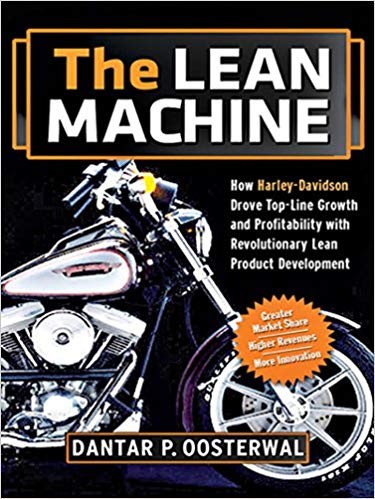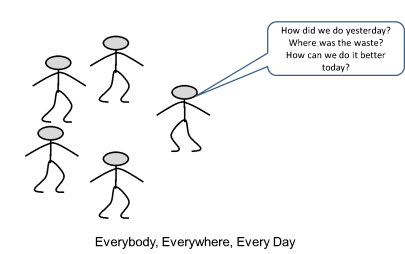Is It Time for New Thoughts on Product Development?
4/29/2019
Most product development teams fail to meet their full potential. They consume more resources than are necessary to test, evaluate, refine their products and struggle to maximize customer and shareholder value. Typical projects take too long, have rocky starts in production, and deliver business results that are often less than expected.
The Situation
Many organizations are seeing great results through the application of Lean practices on the manufacturing floor and as a result Lean Management Systems are becoming widely adopted in those settings. Some organizations are embracing Lean Product and Process Development (LPPD), and there is a vibrant and growing community of practitioners in the field. But as of yet we haven’t seen broad consensus on what the right approach is for improving the new product Introduction process as a whole.
According to Harvard Business School professor Clayton Christensen, each year more than 30,000 new consumer products are initiated and 80 percent of them either fail to launch or never breakeven if they are launched. A study by the Product Development and Management Association (PDMA) found failure rates varied among industries, ranging from 35 percent for healthcare to 49 percent for consumer goods.
"Less than 3% of new consumer packaged goods exceed first-year sales of $50 million — considered the benchmark of a highly successful launch"
Joan Schneider and Julie Hall, "The New Launch Plan."
Coors Rocky Mountain Spring Water, Apple Newton, Google Lively, Amazon’s Fire Phone are some examples of failed attempts.
Common failure modes include:
- Slow to market and missing the opportunity window
- Excessive development time and money spent on products that never launch
- Sales far below expectation or fail to break-even
- Customer adoption rates below expectations
- Unforeseen negative reactions from the consumers once launched
- Actual costs out of line with projections
Business leaders often do not know how to transform their traditional product development practices to a Lean environment or are too risk averse to upset the apple cart by trying something new. Many product development leaders are often comfortable with their current product development process because it’s what they know best, all the while remaining frustrated at the overall results they are achieving. It is hard to recognize that it is the traditional development process being utilized that may be at the center of the problem. Let’s face it, the thought of substantially changing how a team of highly
trained technical professionals carry out their work can be daunting. The devil you know is sometimes better than the devil you don’t know.
However, progress rarely comes without substantive change and perhaps there are lessons to be learned from the software industry and their adoption of Agile software development. Various studies by Forrester, Garner and otherss lead us to some insights on what has worked well, and not so well in software application development. While widely adopted with great success, we are starting to see warning signs of commoditization of Agile software development as noted in the CIO Magazine article and the industry is warned to Be Very Afraid...
Small and frequent product development iterations seem counter intuitive to those brought up in the era of phase gate project management and waterfall charts. A similar mind set shift had to take place in the manufacturing world where batch and que production has been largely supplanted with concepts related to Lean such as flow, and stop & fix. Yet time and again we see faster, better, less wasteful production with smaller batch sizes and improved flow in a wide array of industries.
There is now ample evidence that software developers have widely embraced Design Thinking, Lean Start Up and Agile techniques in their work. This has enabled them to obtain early consumer feedback during the development cycle in comparison to what would have been the case with traditional waterfall methods. This change only came about when people deeply embedded in the process of developing software came to the realization that the methods developed in the early days of IBM are no longer relevant in today’s world.
Methods for planning and controlling costs for software and hardware development are vary greatly. When comparing cost drivers we know – software development expenses are mostly labor, and everyone has access to the latest versions of software technology with very short lead time. In regard to hardware, providing the product developers with the latest and greatest machines and materials can be slow, expensive, or even impossible. Hardware developers have a much longer procurement lead time and legacy infrastructure to deal with. These differences influence how development organizations plan, manage, and run their projects.
cost drivers we know – software development expenses are mostly labor, and everyone has access to the latest versions of software technology with very short lead time. In regard to hardware, providing the product developers with the latest and greatest machines and materials can be slow, expensive, or even impossible. Hardware developers have a much longer procurement lead time and legacy infrastructure to deal with. These differences influence how development organizations plan, manage, and run their projects.
Contemporary market forces being what they are, companies large and small must continually innovate and become more nimble, otherwise they will become isolated from their customers and the markets in which they operate. To be successful, a company cannot allow their product and process development practices to stagnate.
A New Way of Thinking
In 1996 Jim Womack wrote “Lean Thinking” in which he outlined the basic principles of Lean as a system. They are:
- Specify value as defined by the ultimate customer
- Identify the Value Stream and eliminate waste
- Make value flow at the pull of the customer
- Involve and empower the people
- Continuously pursue perfection
Five years later, seventeen software developers met at a resort in Snowbird, Utah to discuss how to take these principles and apply to them to software product development and created what was then known as “lightweight development methods”. The output of that pivotal event was the publication of the Manifesto for Agile Software Development
The Manifesto was based on these basic values:
- Individuals and Interactions over processes and tools
- Working Software over comprehensive documentation
- Customer Collaboration over contract negotiation
- Responding to Change over following a plan
From the core values emerged a set of Agile Principles which are outlined below:
- Our highest priority is to satisfy the customer through early and continuous delivery of valuable software.
- Welcome changing requirements, even late in development. Agile processes harness change for the customer’s competitive advantage.
- Deliver working software frequently, from a couple of weeks to a couple of months, with a preference to the shorter timescale.
- Business people and developers must work together daily throughout the project.
- Build projects around motivated individuals. Give them the environment and support they need, and trust them to get the job done.
- The most efficient and effective method of conveying information to and within a development team is face-to-face conversation.
- Working software is the primary measure of progress.
- Agile processes promote sustainable development. The sponsors, developers, and users should be able to maintain a constant pace indefinitely.
- Continuous attention to technical excellence and good design enhances agility.
- Simplicity, the art of maximizing the amount of work not done, is essential.
- The best architectures, requirements, and designs emerge from self-organizing teams.
- At regular intervals, the team reflects on how to become more effective, then tunes and adjusts its behavior accordingly.
There are remarkable parallels in the Manifesto with Lean principles and it wasn’t by accident. Those defining the manifesto were influenced by the lessons of Lean Thinking and merged that knowledge with their experiences in developing software.
One notable study indicates that in the software industry the inflection point from traditional methods to Agile can be seen in 2010 and a strong trend continued until 2014 at which time it had become the predominant method of software development. TechBecon outlined this in the article Is Agile the New Norm? This is a remarkable shift reflected across an entire industry in just four years.

The software community seems to have figured out small batch, short interval, value creating processes are more effective than complex project management approaches. As knowledge is passed on it typically evolves and grows, the LPPD community has taken a few lessons from some of the contemporary software best practices. Small batch with frequent iteration allows for ‘reality checks’ and fast knowledge capture early in the development cycle create an environment where it is easier and less wasteful to adjust the product design. Dantar Oosterwal has described this concept in “The Lean Machine” and coined the term learning cycles in his work. Agile uses incremental, iterative work sequences known as sprints. Workload is managed with work-in-process kanban boards. One important tool of Agile software development is the daily stand-up meeting referred to as a Scrum. In a brief session, team members report to each other what they did the previous day toward their team's iteration goal, what they intend to do today toward the goal, and any roadblocks or impediments they can see to the goal. Priorities are set in periodic team scrums. Many small learning cycles allow the developers to converge on better solutions. Today’s predominant product development on the other hand is a series of gate reviews, redesign and rework. This approach incentivizes the organization to move highly visible projects to a pre-determined schedule with a long list of open learning activities yet to be concluded. Far too much of this learning is taking place later in the development process and often on the production floor.
Another important tool of Agile is the Retrospective which is what the Lean world would call Reflection. Essentially it is an additional learning cycle superimposed on the product development learning cycles but more focused on the process by which the software was developed and how it can be done better for the next iteration. This continuous improvement of the process is the hallmark of the Lean Management System

So What Is Next?
Applying contemporary Lean Management System principles and Agile methodologies to the LPPD process will accelerate and improve learning cycles, making each iteration better, as well as more valuable. Leaders can begin by making the gaps found in the current state results visible through visual management tools, and facilitating the discussions within the organization to practice sound problem solving techniques. The next step is to add some Agile principles and techniques to the product development toolbox in a manner that specifically addresses those identified gaps. Like Lean, Agile is about making problems visible more quickly at the working level, being flexible, and responding rapidly to changes in feedback, requirements, and market needs rather than putting the best face on the current state. In order to do that, Lean Thinking culture is necessary, as it enables dealing with problems overtly and effectively in order to successfully bring new products to market.
Has the time come to make similar change happen in how products are developed, produced, and introduced to the market place as what took place in software industry did in 2010?
Do we have a choice?
What do you think?
Comments:
This post is more than 730 days old, further comments have been disabled.
Contact The Murli Group
Find out how we can help strengthen your company from the ground up»

